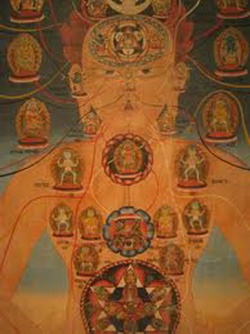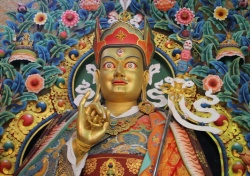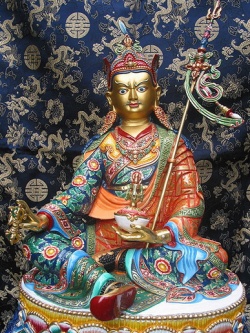The Importance of the Guru in Vajrayana Tradition
(From a teaching on Life of Guru Rinpoche by Bardor Tulku Rinpoche given in Seattle, WA, in April 2009. Translated by Lama Yeshe Gyamtso, transcribed by Linda Lee, copy-edited by Basia Coulter.
In vajrayana, we are taught to view our guru as the complete embodiment of the trikaya—three bodies—as the overlord of all buddha families, the principle of all the mandalas, the embodiment in the single form of all yidams.
Some people, who have studied Buddhism from the outside, have questioned this. Observing the tremendous emphasis placed on the guru in the Tibetan Buddhist vajrayana tradition, they have called this not Buddhism but Lamaism. And they make a distinction between Buddhism and Lamaism. They say that all that Tibetan teachers talk about is lama, lama,
lama, lama this; serve the lama; venerate the lama; pray to the lama; give to the lama, etc. It is just nothing more than a self‑serving advertisement. To be honest, of course, there are lamas who justify this criticism. Obviously, charlatans exist as they do in every tradition, but it is not true that any authentic guru is self‑serving.
Authentic gurus teach the path of devotion and faith not because they need our devotion or our faith, but because we do. Authentic gurus do not want or need our respect. They have no use themselves for our service. They do not want or particularly enjoy our wealth. This is because they have no hope or fear. Hope and fear are born of dualism. Authentic gurus are not dualistic, therefore, respect and disrespect and so forth are irrelevant to them. However the
fact remains that while the guru may not need you if you whole‑heartedly supplicate a guru who is authentically beyond dualism, you can achieve the same state as his in a single instant. In a single instant, you can achieve what we call “the mixing of the guru’s mind and your mind.” And it is this whole‑hearted open supplication that makes vajrayana the fastest possible spiritual journey.
The Buddha’s teachings are incredibly vast. Even among the teachings of the sutras alone, the teachings of the Tripitaka, the Vinaya, sutras, and Abhidharma are so vast that probably no one could even read through them once in a single lifetime, let alone attempt to practice all of them. And yet, in this (vajrayana) path, we do not have to go through that process. The entire vajrayana path can be traversed in less time than it takes to read through the sutras. It is said, “In a single instant, the difference is made. In a single instant, samyaksambuddha is achieved.”
Among gurus, Guru Rinpoche is extraordinary. He is extraordinary in his responsiveness, among other ways [in which he is extraordinary). It is said, “Padmakara sleeps outside the door of everyone with faith in him.” It is as though when you have faith in him, he is literally sleeping outside your door at night. His emanations, such as the hundred treasure revealers and others, have been innumerable and it is also said that he truly appears among us on every 10th day of the waxing phase of the lunar month.
Through this kind of faith and devotion in this kind of guru, we can actually achieve the state of great unity, the state of Vajradhara. So if you want to be a genuine practitioner, remember that it depends upon having unfluctuating devotion, unfluctuating love and compassion for beings, and unfluctuating and ruthless honesty.
From the point of view of an authentic guru himself, his qualities are endless and innumerable. In the tantras, it is said, “The guru is the buddha. The guru is the dharma. The guru is the glorious heruka. The guru is everything.” Nevertheless, in spite of the perfection and completeness of our guru’s qualities, whether or not we receive our guru’s blessing depends entirely upon our own attitude. The attitude we need is such that we actually
view the guru as the embodiment of the Three Jewels; we think that the guru’s body is the Sangha, his speech is the Dharma, and his mind is the Buddha. We view the guru as the embodiment of the Three Roots, inclusive of the gurus—roots of blessing; the yidams—the roots of siddhi; and the dakas and dakinis—the roots of
activity. We regard our guru as the overlord of all buddha families and all mandalas. And this attitude is one‑hundred percent genuine; simply trying to convince yourself of that or faking it is not going to help. If we have that kind of attitude, we will definitely receive the guru’s full blessing and by receiving that and by that alone, we will achieve the fruition of this path.
In that way, the blessing of our root guru can be even greater than the blessing we would receive by meeting the historical Buddha. But if we think that the guru, although far superior to most others, is still not quite the same as the Buddha
(after all, how could he be like the Buddha himself?), then we will receive less blessing than blessing of the Buddha. And if we think that the guru is somewhat superior to us (obviously), but how much we do not know, then we’ll receive the blessing of someone somewhat superior to us, but how much we do not know. And if we think that the guru is actually stupider than we are, then we’ll receive the blessing of someone stupider than we are.
The problem is that as long as we fail to mix our minds with dharma, the single moment in which the difference is made, that single moment in which samyaksambuddha is achieved, will remain very, very distant from us. If we mix our mind with dharma, then the guru and the guru’s blessing are immediately available. From that point of view, it is irrelevant whether the guru
is physically close to us or physically distant, whether the guru is still alive or has passed away. None of these things make any difference as far as the guru’s ability to bestow blessings is concerned because the blessings of an authentic, realized master are unceasing throughout all time. There is no such thing as physical distance where blessings are concerned.
A great deal has been written in the Jewel Ornament of the Liberation and in other books about how to attend gurus, how to relate to gurus, and so on. But fundamentally it all comes down to devotion. Especially for us of the Dakpo Kagyu devotion alone is the substance of our path. Even if someone were a mahapandita, who knew absolutely everything there was to know about Buddhism in terms of facts and terminology, without devotion it would not be possible for him or her to achieve the fruition of this path.


